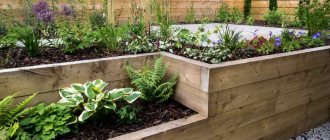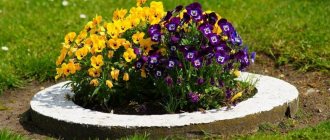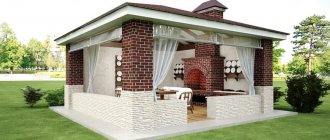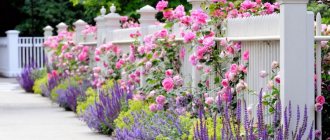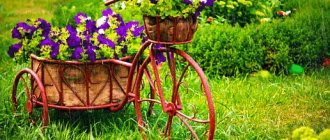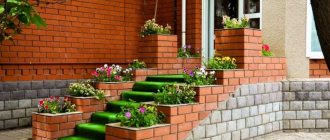Home » Landscape design » Flower beds and flower beds
Vladimir 05/07/2020
69548 Views
Do-it-yourself flowerbeds in the country
The flower garden is a small architectural wonder surrounded by emerald green grass. Flower beds include both single and group plantings, decorative elements, paths, platforms, small architectural forms in the form of sculptures, fountains, etc. Join the fascinating world of landscape design - create a flowerbed at your dacha with your own hands!
Introduction
Based on your wishes, you can create the flower garden of your dreams with your own hands.
Parterre (geometric) flower beds have a symmetrical shape and are usually located in front of the entrance to the building. Open-plan flower beds provide more room for imagination compared to ground floors. They can be designed taking into account the unevenness of the landscape, and installed in a quiet area of the garden, near the pool.
Stone bricks are an excellent solution for zoning
The background for a flower bed, as a rule, is decorative shrubs with attractive foliage colors or small beautifully flowering trees. When creating flower beds, various types of decoration are used: solitaires, rutaria, alpine slides, arches, borders, etc.
Tapeworm is a solitary growing plant that looks spectacular at any time of the year, stands out against the general background of the flowerbed, forming a bright spot. The purpose of a tapeworm is to attract attention. The life of the entire flower garden revolves around the tapeworm.
Dwarf spruce will perfectly cope with the role of tapeworm
For single plantings, use light-loving plants; they can be either annuals or perennials. Among annuals, decorative sunflower, burgundy amaranth, castor bean are good as tapeworms, among biennials - mallow, foxglove, among perennials - queen of shade astilbe, daylily, tree peony.
High flower bed made of concrete blocks
This is what a flowerbed looks like, which you can make yourself.
To do this, first of all, we outline the contours of the future flower bed on the ground and dig a ditch.
We install the concrete blocks evenly and carefully, checking from time to time for correct installation.
We concrete around the installed blocks and level them well.
We wait for the concrete to dry completely and fill in the prepared soil.
The high flower bed is ready, you can plant suitable plants. Due to the fact that it is tall, the flowerbed will be a clearly visible, bright decoration of the site.
Slough show: the story of one flowerbed
How the flower garden in the city has changed - through the eyes of a high-rise building tenant
Flowerbed, like from a magazine cover
An enviable decoration for your home
First, decide how much time you can devote to flower beds. If at your dacha there is only a flower garden, and you direct all your strength and energy only to it - this is one conversation, but if there is also a vegetable garden, beds with strawberries, potatoes, tomatoes, cucumbers, a berry garden, there will be very little time left for flowers.
Vegetable bed
Sometimes novice gardeners buy an expensive flower in a single copy, plant it in their flowerbed, and then wonder why the flowerbed doesn’t look as attractive as on the covers of glossy magazines?
Dear flower growers, not all plants, even the most beautiful ones, look impressive individually. Use group plantings to create pops of color in your flower garden. This is a wonderful technique for decorating a beautiful flower garden.
Why isn't your flowerbed like the one on the magazine cover? Read below!
For group plantings, take several plants of the same species in different color shades. You can use annual, biennial and perennial crops.
Look how great the band looks in purple. It contains phlox and daylilies, the queen of the garden - the rose and such a simple but sweet field geranium.
When creating group plantings, choose plants with a long flowering period so that they do not lose their decorative effect throughout the season.
There are some plants that look very impressive before and after flowering. Seed pods and foliage remain on them, and they continue to decorate the flowerbed even after the end of their growing season.
In mixed groups there should be a selection in height, plants should not obscure each other, everything should be harmonious.
Place groups in your flowerbed in tiers . The lower tier consists of ground cover and low-growing plants; they look good near paths and alleys.
Primrose is a great option for the bottom tier of your flower bed.
If you decide to place a group near a tree trunk, then retreat 20 -30 cm. Groups can contain from three to ten plants.
Choosing the right location
In order to correctly plan exactly how to lay out the selected flower garden in front of the house, you should make a sketch on paper. It would be better if it was in color for clarity. Then you can not only correctly plan the space allocated for this purpose, but also calculate the need for planting material and fertilizers that will be needed to make the idea a reality.
Recent Entries
Lilac perennials that are beautiful, compact and do not crowd out other plants Why when buying seedlings you should not take the sellers’ word for it and how to determine the age of the plant using 3 signs Tomato seedlings have turned purple or whitish: why the color has changed and how to save the plants
It should be noted that when planning a site for a flower garden, you need to provide for all the nuances of its subsequent care. For example, it is better not to plan plantings that are too wide so that each crop can be easily reached. Typically, plantings should not be wider than 2.5 m.
Agree that this placement of the flower garden allows you to decorate absolutely any home. A romantic mood, a surge of strength and emotions in such a home is guaranteed
The choice of a place opposite the house or near it is natural, although it does not exclude the possibility of planting several flower beds in different parts of the garden. There are wonderful places for this purpose along paths, on the shores of reservoirs or in the gazebo area. It is important that the specific location is determined already at the planning stage.
Based on the existing experience of such plantings, we can suggest that the gardener plan a flowerbed with some reserve of territory “for growth”. Usually, with a positive result, there is a desire to complement an existing flower garden and transform it. After all, the visual result, as a rule, exceeds the plans. To give your wildest dreams the opportunity to come true, the territory set aside in reserve will come in handy.
Floral arrays
Unlike the group, the massif occupies a large area that can extend for tens of square kilometers. Arrays can be plain or variegated.
Suitable for single-color arrays:
- lavender
- phlox
- poppies
- tulips
Floral array of tulips of different varieties
It is not easy to create a high-quality massive planting. It should be harmonious, the colors should complement each other. For example, an array of blue pansies, which are located in the foreground, gradually turning into more saturated blue irises.
Contrasting array without further ado
Creation of contrasting arrays is allowed.
The following options are possible:
- pink phlox and white delphiniums
- delicate white daffodils and bright red peonies
- fiery swimsuit and purple cockerels
Fashionable and original solutions for designing flower beds
Ordinary pots and flower beds can be revived and transformed with the help of unusual ideas. Decorative flower beds can be made from all kinds of available materials. For this you will need:
- tires
- old stumps,
- tree trunks
- old furniture
- old buckets and watering cans
- plastic bottles.
Shoes can become very fun flower pots; you just need to fill them with soil and plant flowers.
Flowerbeds are part of the flower garden
Flowerbeds can be placed in the center of the lawn, along the garden path, around a pool or fountain. They can be oval, round, diamond-shaped or polygonal. Nowadays it is customary to make flower beds flush with the lawn or even deepen them a little.
Play with small architectural forms: statues, fountains
Carpet flower beds made from ground cover plants of various colors in the form of ornaments look very beautiful. It is customary to mulch the soil between plants with sawdust and pine needles.
Beautiful ideas for creating a flower garden
The beauty of a flower bed depends on the correctly selected varieties, arranged in a certain pattern. But we must not forget about arranging the flower garden itself. A good solution would be to designate clear boundaries. You can use any available materials.
You can make an original flowerbed in the center of the site from wood. This could be a low fence made of boards or stumps, or hanging structures. To create flower beds of various heights, you can use stones and bricks. An “alpine slide” will fit perfectly into the landscape design.
The garden will be decorated with original flower beds made from old tires, furniture, and plastic bottles. You can use a rusting car that cannot be repaired, a metal mesh, or an old piano.
Border
An important element is the border surrounding the flowerbed. The border gives the flower garden completeness. You can also make a “living” border from low, brightly flowering annual plants, such as marigolds or low-growing begonias.
The border neatly outlines the flowerbed, giving it completeness
When selecting planting material, you need to proceed from the following considerations:
1 the plant must be dense and bushy
2all plants must be the same height
3maintain its attractiveness after flowering
4easy to tolerate trimming
5be resistant to temperature changes
Petunia flower border
Options for borders
Annual plants:
- lobelia
- Chernobrivtsy
- low growing carnation
- fuchsia
- cineraria
- brachycoma
Perennials:
- catchment area
- host
- day-lily
- Heuchera
Rabatka
A rabatka is a long strip of land planted with ornamental plants.
Rabatki are good for arranging garden paths and alleys
They highlight the foundation of the building well. As a rule, ridges are not wide up to 2.5 meters.
There is no need to do very long work. If you need to plant a fairly large area, then simply make gaps of half a meter between the ridges.
Plant the gaps with low-growing shrubs: boxwood, spirea.
According to the height of the plants, ridge plants are divided into two types:
1 One-sided - in this case, low plants are planted on the front side of the ridge, then taller ones and, finally, the tallest ones in the background.
2 Double-sided - in this case, tall plants are located in the center, and low plants are located at the edges.
According to the color scheme, discounts are divided into single-color and multi-color.
When creating single-color flower beds, garden plants of the same type and color range are used. In multi-color discounts, you can combine different colors at certain intervals. Multi-colored discounts are more attractive and elegant.
Key points in creating a flower bed
Plants should be planted in a flower bed taking into account their height. Small types of flowers are planted along the edges, but the closer to the center, the greater their height should be. The longest ones should be placed in the middle of the flowerbed.
Select plants that will look harmonious in the overall composition. Color shades can be combined with each other or, conversely, contrast with each other.
When creating drawings, it is better to abandon intricate sketches. A simpler idea for decorating a flowerbed in a country house will not be inferior in its beauty to its complex ones.
Each registration process has its own nuances, which are best familiarized with before proceeding. Some landscape design secrets will help you organize a luxurious and harmonious flower bed that will match all the buildings on your garden plot.
Assortment of plants for an attractive garden
Annuals:
- Chernobrivtsy
- petunia
- brachycoma
A flower bed of ground cover plants along the garden path
Biennials:
- pansies
- daisies
- rose stem (mallow)
It is not easy to create work from perennial plants.
Varietal composition for perennial ridges:
- low growing aster
- tree peony
- delphinium
- day-lily
- Heuchera
- small petal
Mixborders
Combined mixborder along the fence
Mixborders are multi-row flower beds of ornamental plants . The plants are selected so that when some fade, others immediately bloom, and the mixborder remains attractive throughout the season.
A flower bed that is attractive in the off-season is the pinnacle of a florist's skill
Mixborders are often placed along buildings, on lawns, and near swimming pools in the form of bright color spots. The edges of the mixborder are limited to lawn grass or laid out with tiles, stones, and stump cuts.
Perennial cereal grasses look beautiful in mixborders
The selection of plants should be such that the flower garden will be a decoration throughout the entire summer season. For mixborders, annuals and biennials are used, but the main place, of course, belongs to perennial plants.
Use pebbles to fill empty spaces between plants
The background for a mixborder can be:
- pampas grass bush
- tree peony
- barberry
- dogwood
- small beautiful flowering tree
Combined mixborder along the fence
Alpine slide
This is a miniature rock garden. The main task when constructing a rock garden is to ensure that it fits organically into the landscape . It is worth remembering that this style of garden art originated in ancient Japan.
The Japanese, above all, value harmony and peace
Alpine slides have gained unprecedented popularity in our time. Apparently our people lack quiet contemplation of natural beauty.
Making a good rock garden is not as easy as it seems at first glance
Planning should proceed in several stages. First of all, it is necessary to organize there is natural planning; it, as it were, stylizes the motifs of the mountain landscape.
- Choose areas with a slope or terraces.
- First, drainage is done, because mountain plants do not tolerate stagnant water.
- The top layer of soil is removed, buried 20–25 cm, crushed stone or broken brick 5–10 cm thick is laid.
- The stones should be matched in color and laid parallel to the surface of the site; stones should not be piled up chaotically.
- Use sandstone, limestone, granite, natural stones. Avoid regular shapes and right angles.
- The stones need to be installed firmly, because in the future it will be possible to move along them, weeding and loosening the rock garden.
- Fill the space between the stones with decorative pebbles or mulch with large sawdust and pine needles.
Stones are an integral part of the alpine slide
Install the stones firmly, you will have to climb on them while weeding the alpine slide
Laying a rock garden
If the plants you plan to plant like acidic soil, add peat chips, and if they prefer alkaline soil types, then you need to lim the soil with lime.
It is not recommended to use manure and large amounts of nitrogen fertilizers, as the plants will begin to vegetate wildly, this will give them an unusual appearance, they will stretch out, become unstable to diseases and lower temperatures.
In addition, manure can contain a huge amount of weed seeds, and as you know, weeds are the worst enemies of flower beds.
Early flowering crocuses take pride of place on alpine hills
In the first 2 - 3 years you can not apply fertilizers at all; in subsequent years you need to add a little superphosphate.
The range of plants used for alpine slides is very wide
Cereals:
- ground cover plants
- all kinds of bells (Carpathian bellflower, Campanula angustifolia)
- Heuchera
- looked younger
- bloodroot
- saxifrage
- savory
- lavender
From early flowering plants you can plant:
- crocuses
- saffron
- decorative bow
- hazel grouse
- hyacinths
Single growing ferns will look beautiful.
Among the shrubs there are many attractive low plants that are suitable for decorating an alpine slide:
- barberry
- heather
- rhododendron
- low growing spirea
- euonymus
- boxwood
Sedum and young - a standard set for a top-end rock garden
Coniferous plants look beautiful: decorative low-growing Christmas trees, pines, yew, juniper.
Decorative fencing made of wooden pegs
For a summer cottage, a great idea would be to decorate a flower bed using wooden pegs. In summer cottages you can often find broken branches of trees, which are suitable for blocks with which you can make a flower garden fence.
Perennials in flower beds
Take care to get the greatest effect from the least amount of labor. There is a way out - these are perennial plants. Even at the planning stage, allocate space for a flower bed.
If you expect that the flowerbed should be visible from the window of the house or from the gazebo, do not hide the flowers away from recreation areas . It is up to you to create a flowerbed of any shape - round, with right angles, in the form of diverging rays.
Perennial plants are a good choice for mixborders
Perennials look very beautiful as part of mixborders - these are prefabricated flower beds. They are usually organized along garden paths or along fences.
Perennial flowers are demanding of sunlight, under the canopy of trees, in the twilight they turn yellow, stretch out, and lose their beauty
Mixborders can be placed next to perennial fruit trees and berry bushes.
When laying a mixborder, keep in mind that its width must be at least two meters, otherwise the attractiveness will be reduced.
First steps. Size and shape
The main difference between a flower bed and a flower garden is its shape. If a flower garden can have absolutely any shape you want, then the flower bed is made only in strict geometric configurations (circle, oval, rectangle, square). This may be any geometric figure, but with smooth and clear contours.
Flowerbeds with a distinct geometry look more attractive on a flat, well-groomed lawn. It is worth noting that the shape of the flower bed should be visible from each side, otherwise it will look sloppy.
In order to prevent such a situation, it is recommended to pay attention to two important points.
The first is a diagram of the future composition. The process of creating it is quite simple; it is necessary to draw the outline of the planned object on the prepared area.
The second point is the density of planting. Here you should take into account their growth characteristics when using several different varieties. For example, planting identical plants must be done according to the “carpet” principle, placed extremely close to each other.
If there are empty areas among the flowers, this will ruin all the effectiveness and spoil the geometric integrity. Options for beautifully designing a flowerbed like a “carpet” can be seen in the photo.
The dimensions and shape of the future flower bed completely depend on the size of the site itself. If there is an opportunity to create a large front garden, then it is worth taking advantage of it. After all, massive flower arrangements have a more attractive appearance in contrast to small islands.
If you are not an experienced gardener, then as a first experience, make it simple in shape with a simple design.
Soil preparation
It is advisable to prepare the soil 3 to 5 weeks before planting flowers in the flower bed
- Provide good drainage. Standing water negatively affects the physiology of flowering plants.
- Perennial plants can go into a state of suspended animation due to waterlogging.
- There must be air in the soil, the soil must be moisture-absorbing and fertilized.
- If there are a large number of weeds, you need to remove them, dig up the ground, and get rid of the roots of perennial grasses, especially the rhizomes of creeping wheatgrass.
- Organize drainage, lay it to a depth of a couple of bayonets of a shovel.
- Compost, humus, and peat chips have a beneficial effect on the quality of the soil.
- If your site has clay soil, you need to add sand and half-rotten sawdust.
Planting flowers in a flower bed
The best time for planting flowers is spring, and for bulbous and early-flowering perennials, autumn
1Irises should be replanted after they have flowered, this is the most favorable time, they are at rest, and after a month and a half they begin to grow a new root system.
2When planting perennial plants, remember that the planting holes should be such that the plants can easily spread their roots into them.
3The depth should not be excessively large; the best option is when the lump is completely located in the new hole.
4Freshly dug soil around the planted plant should be compacted, eliminating voids in the area where the root system is located.
5It happens that after the first watering the soil sags; in this case, add fresh soil.
6Leave a small depression to make it convenient to water the plant.
Watering
The best time to water is early morning
In summer, perennial flowers need to be watered often and in large quantities. If they lack moisture, they will bloom poorly and will not have the desired aesthetic effect.
Do not water the plants on the leaves, pour water directly under the roots, this way you will avoid the spread of powdery mildew.
Do not forget to remove faded branches, inflorescences, and leaves that have lost their attractiveness. Try to keep your flowerbed decorative for as long as possible.
Conclusions and wishes
In this article, we briefly discussed the question of how to design a flower garden at the dacha with your own hands for beginners, watched a video on creating a flower garden, and photos of interesting options for flower beds. I think there was something useful for you in the material presented.
In the presented examples there are no “cool” flower beds that are difficult to implement. After all, the article, judging by the title, is intended for novice flower growers and landscape designers.
Of course, when planting and decorating a flower garden, it is advisable to have some basic knowledge of floriculture and landscape design. But it’s equally important to just do it with your soul and be creative. And then everything will work out for you!
Best regards, Alexander Tkachenko.
Layout
Perennials are grouped by growth, flowering time, color, and type of leaves. Choose plants that are not particularly labor-intensive to care for.
Moderately labor-intensive perennials include:
- astilbe
- aster
- geranium
- primrose
- brachycoma
- cloves
- sedum
Foxglove requires virtually no care
Among the unpretentious ones the most popular are:
- monarda
- stock-rose
- digitalis
- lily of the valley
- digitalis
- lavender
- phlox
- lovage
Formation of compositions
When arranging flower beds, assume that the main colors are red, blue and yellow.
Flower beds with plants of the same color, but in different shades, look beautiful
Green, purple, and blue flowers look beautiful in the foreground. Cool shades are perceived better up close, because the further they are located, the less impression they will make and will merge with the surrounding landscape.
Also, when creating flower beds, use white color, plants with silver foliage, they look very impressive and, as it were, soften the impression of contrasting neighbors. When creating flower beds, the emotional side is very important, how the plant is perceived by us, people.
The aesthetic side is one of the most important in creating flower beds
Look at the peonies, how luxurious they are, large, majestic, covered in drops of dew, almost the size of a saucer, heavy with the abundance of petals. Forget-me-nots and viola will look beautiful next to peonies.
It is necessary to plant these crops in the most accessible places in your garden; peonies have few competitors that would look so decorative. Projects of two-story houses Z500 https://z500.com.ua/doma/poisk/dvuhetazhnye-doma.html on the official website https://z500.com.ua
Peony bushes need space and green lawns
In early spring, the burgundy sprouts of these flowers look attractive and elegant. After flowering, the bush keeps its shape for a long time and even in autumn pleases with its yellow, red and brown colors, standing out against the background of the lawn and shrubs.
Fencing made of large stones, boulders, concrete
Large natural stones are often used to decorate rocky gardens and flower beds. Large boulders look incredibly beautiful when enclosing a flower bed with tall flowers. Flowerbeds made of stones are easy to make yourself; they look very colorful.
The strongest and most resistant stone and concrete fences, they will last much longer than wood or plastic. They have excellent wear resistance and do not require constant maintenance. Concrete is a fairly durable material, excellent for creating edging in the form of low walls, strips that are flush with the ground.
Primroses
One of the first flowers after the snow melts
- Bulbous flowers evoke tender and tremulous feelings; these are the first flowers after winter that we have been waiting for for so long.
- They look touching against the backdrop of the remnants of snow; they should be placed closer to paths and garden paths so that you can admire them.
- Make sure your garden looks decorative from early spring to late autumn. Yes, it's difficult, but possible.
- Take into account all the features, remember that early flowering plants are usually short, so they will need a good background to highlight their beauty.
- Use boxwood bushes, low-growing thuja or juniper as a background.
climbing plants
In flower beds, climbing plants are located on supports, usually in the center
- Lianas and climbing plants are always welcome guests in the garden. They are distinguished by rapid growth of shoots, carved foliage, numerous flowers, and sometimes attractive fruits.
- To achieve maximum beauty, you need to use supports and create an appropriate background.
- Use combinations of contrasting colors, for example, clematis can be planted in dark purple and white.
- The supports should be comfortable and easy to use.
- Climbing plants can decorate lamp posts and unsightly buildings.
Planting a flower bed - step-by-step instructions
- First of all, you need to draw up a project, make a breakdown, plant plantings. And of course, provide constant care.
- You can make a planting drawing yourself on a piece of paper, or you can use computer programs for landscape design.
- Here is a list of some computer programs for creating flower garden designs.
- After creating a flower garden, you need to write a statement that will contain information about the varieties, hybrids, plants planted, the quantity, and frequency of planting.
- Before planting, it’s a good idea to familiarize yourself with the biology and agricultural techniques for growing certain crops.
- Place flowers taking into account their size, so that they do not block the plants behind them. Consider flowering time.
- If you follow all these rules, the flower garden will look beautiful and attractive from early spring to late autumn.
- Next to bulbous plants that will flower early, tall perennial plants can be provided so that they cover bald spots.
- Once you have finished laying out all the elements in your flower bed, till the soil.
- Don't go beyond the boundaries you set.
- Remove the roots of weeds, especially the rhizomes of creeping wheatgrass, stones, and other debris.
- In case of severe soil contamination, imported soil must be brought in. Remove the top 25 cm layer of soil, fill the vacant space with a specially prepared soil mixture of humus and rotted leaves.
- You can start planting cold-resistant plants in early spring; do not be afraid of frost.
- Start planting heat-loving plants in late May.
- To prevent you from trampling the ground, use boards and stands.
- Planting should be done starting from the center of the flowerbed and gradually moving towards the edges.
- Do not forget that the flower garden must be constantly cared for, only in this case it will look aesthetically pleasing.
- Ensure timely weeding and loosening.
- Faded inflorescences and dry leaves must be removed.
Provide timely watering, and the plants will thank you with lush flowering
- If the summer is especially dry, watering should be done in the morning and evening; watering should not be done during this time.
- Feed the plants with fertilizers three times: in early spring, during bud formation, and during flowering.
- Apply ammonium nitrate, phosphate and potassium fertilizers.
Flower beds in the courtyard of a private house: photos of original ideas
Flower arrangements using old vehicles
Any old vehicles that are unsuitable for their intended use are suitable for this purpose. It often happens that it is a pity to throw them away and they stand idle for years in a barn or garage. Thanks to your imagination, such things can take on a new life. Absolutely anything can be used: bicycles, motorcycles, old cars and even boats.
An original flowerbed in the courtyard of a country house
To create a flower garden using a bicycle or motorcycle, you need to attach spacious containers to the frame, front and rear racks in which you can plant flowers. To unite all the elements, it is recommended to paint them in a single color scheme. This will give the mood to the entire structure. An important advantage of this type of flower garden is mobility. The ability to move it to another location at any time significantly expands the options for further use of the space.
The flowerbed-car will become a unique element of the design of the garden area
If you use an old boat or car, the flowerbed will be stationary, but at the same time more voluminous. The boat is perfect for creating a decorative flowerpot. To do this, it is enough to firmly fix it on the ground and fill it with soil. Use the same principle with a car. Remove all unnecessary parts from it: seats, engine, trunk and hood filling. Then you can start decorating with flowers.
An old bicycle painted in a bright color is an excellent option for creating a flower garden.
Helpful advice! To arrange “transport” flower beds, it is better to use a spacious open lawn. Otherwise, the structure will take up too much space and clutter up the space.
Various vehicles can act as a flowerbed - from a bicycle to a boat.
Using a special mesh filled with nutrient soil, you can decorate horizontal and some vertical surfaces. It is best to use climbing or small border flowers in this case.
Mini-flower beds in containers made from scrap materials
Creating miniature flower beds in containers is an elegant solution to two problems at once: decorating a summer cottage and getting rid of old unnecessary things. In addition, this arrangement of flowers will help protect them from children and pets. To create a mini-flower bed, you can use anything: from old plumbing to unnecessary clothes and shoes.
Flowers growing in wooden boxes are a mobile and attractive flower bed option
Flowers planted in old shoes look very original. At the same time, the larger the shoe size, the more interesting it can be decorated. Making a flower pot from worn-out shoes is simple: you need to make several holes in the sole, which will help create a drainage system. After this, the inside of the shoe is filled with earth and flowers are planted inside.
Mini-flower beds arranged in shoes look interesting and unusual
A clear advantage of such an improvised container is the ability to easily move it to a convenient place. You can always place it on your porch, fence or steps. This will allow you to easily decorate the interior at the right time.
An old birdcage can be a good base for creating a flower bed.
Among the disadvantages, it is worth noting the need for daily watering and weekly feeding.
Old toy cars of sufficient size, leather bags and briefcases, a cracked jug, etc. can also be an excellent basis for mini-flower beds.
Wooden flowerbed palette
Such an unusual and original flower bed is quite simple to make and does not require advanced woodworking skills. Materials you will need:
- plywood sheet;
- wooden blocks;
- hand cutter along the contour;
- varnish or paint for woodwork.
Design option for a wooden flowerbed-palette
First you need to cut out the palette shape of the required size. Then make holes for the pots of the required diameter. Two legs are attached to the back of the structure so that the surface is located at a slight angle. In order to increase the life of the flower bed, it is coated on the outside and back with a special varnish or paint for wood. After drying, you can insert pots with bright flowers inside.
“The Artist’s Flowerbed” looks original and is quite simple to implement
An excellent solution for such a flower garden would be pots with petunias, nasturtiums or violas. And don’t forget to complement the composition with a rake and a shovel, because these are the tools of a gardener-artist with which he “paints” the world around him.
Creating beauty in the surrounding space is the true calling of man. Using the recommendations given, you can create a unique flowerbed that will delight you every day throughout the warm season.

